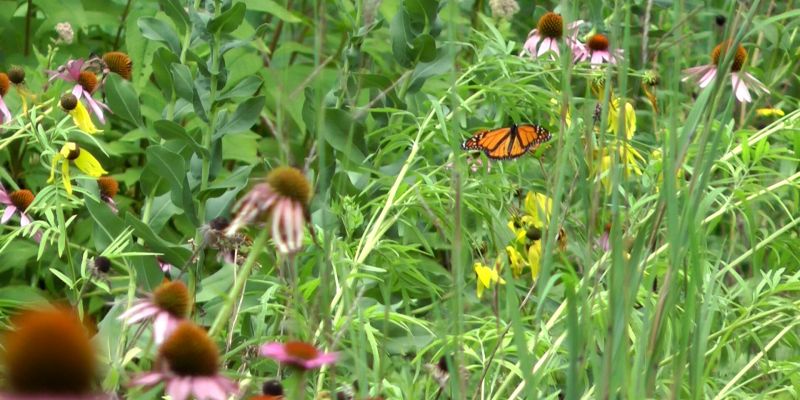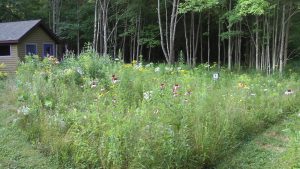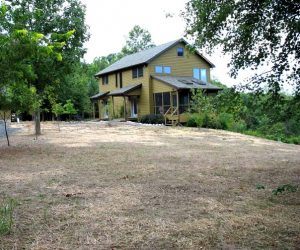
Why do people have lawns? “I think most people want a decent looking landscape around their homes and that can be achieved quite simply with a lawn,” explains Angela Sisson.
Lawn around the house, especially in high traffic and play areas, makes a lot of sense because turf grass is such a durable ground cover and easy to maintain. Periodic mowing of small lawns neatens up the place with very little effort.
What does not make sense, are large, under-utilized lawns; they not only require time-consuming maintenance, they tend to be hazardous to the environment. Hazards such as chemical runoff from herbicides and fertilizers, storm-water runoff (the short root systems absorb little rainwater) and the inability to support wildlife, to name a few.
There are alternatives to large lawns. A garden can be an appropriate alternative, if one can commit to more maintenance than the original lawn. But that’s rarely the case. Probably the best alternative to a large lawn, especially for outlying areas, is a meadow. There are several different methods of installing a meadow, but those likely to succeed will require serious work the first two seasons.

Where once was lawn …the Sisson property being prepped for lawn replacement in 2006 (inset) and its current meadow in summer. All photos courtesy Angela Sisson. Visit our facebook page for more pictures.

There’s no shortcut to achieving a successful meadow. Avoid the meadow-in-a-can (quickie) approach that uses annuals (mostly non-native). The first season or two will produce a flush of colorful “wild” flowers, but thence forward the meadow will be overrun with weeds. Also to be avoided is doing nothing, or “letting nature take its course.” With these methods, aggressive, invasive weeds are too well-established and desirable plants cannot compete; the key to a successful meadow is the removal of aggressive weeds.
Inspired by the native purple love grass which grows abundantly along many northern highways and blooms purple in September, Angela began researching grasses, prairies and wildflower meadows. In particular, the prairie restoration movement in the Midwest provided a wealth of information, which she worked to translate into her own landscape. With no examples in the region to draw from, she took the plunge in 2006 and replaced a one quarter acre area of “outlying” lawn with meadow. Three years later she replaced another quarter acre. By this time she was able to design her own seed mix, exerting more control over the plant species. Next year she plans to plant the final quarter acre, replacing the last of the outlying lawn.
Meadow plantings take a two-year work commitment. After that the maintenance is just one mowing (or burning) per year. The first season is about preparing the area—removal of lawn (and weeds). Meadow seeds, a mixture of native grasses and wildflowers, are planted in the fall of the first season. The seeds overwinter on the bare ground, working into the soil with the freeze and thaw activity. The second season is lots of mowing—but as high as possible—in order to cut back the weeds without harming the native meadow plants, which are tiny at this stage, spending early growth establishing root systems. During the second season, with lots of weeds showing up, Angela thought her experiment had failed, but more experience and research showed that annual weeds aren’t much of a problem in an early meadow. It’s too many perennial weeds in an early or struggling meadow that can spell disaster.
Angela’s advice for beginners is consider starting with a manageable area, perhaps a few hundred square feet of lawn at a back edge. Research installation procedures and follow them carefully. Learn to recognize annual and perennial weeds (and weed seedlings). Don’t worry about annual weeds, meadow plants will out-compete them in time. And be aware that meadow horticulture is counterintuitive—don’t water, it encourages weeds, and don’t weed, the disturbance also encourages weeds. A meadow installation takes work and patience, but the rewards are significant.
Probably nothing in the landscape changes as often as a meadow; it changes all year long as well as from year to year as it matures. It takes a few years before the meadow looks like something and before the weeds are on the decline and the wildflowers dominate, but by then the meadow has become a living thing as birds, butterflies, dragonflies and other wildlife make it home.
“Last June and July I would walk the path through my newest (2009) meadow and see upwards of a dozen hummingbird moths flocking around the lavender blooms of wild bergamot. It was kind of magical,” said Angela. “At times the beauty of these meadows almost takes my breath away.”
Editor’s Note: Lawns originated in Europe and only became popular in America—mostly among the wealthy—in the late 19th and early 20th Centuries. With the invention of the lawn mower and the expansion of the suburbs, lawns soon became widely popular. Today, we have 40 million acres of them. Yale University estimates that the United States uses more than 600 million gallons of gas to mow and trim lawns each year—about two gallons of gas for every man, woman and child.
